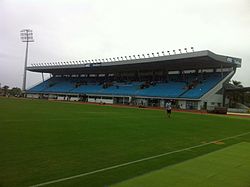sport.wikisort.org - Stadium
The HFC Bank Stadium ( formely known as ANZ Stadium)[3] is a multi-purpose stadium in Suva, Fiji.
 HFC Stadium | |
 | |
| Location | |
|---|---|
| Coordinates | 18°9′0″S 178°26′57″E |
| Owner | Government of Suva City |
| Operator | Government of Suva City |
| Capacity | 4,300 (stadium seating)[1] 15,000 (total with embankments)[2] |
| Construction | |
| Built | 1951 |
| Renovated | 1978–1979 2012–2013 |
| Tenants | |
| Suva Highlanders Suva FC Fiji national football team | |
HFC Stadium is used primarily for rugby league, rugby union and football matches, and features a track as well as a pitch suitable for worldwide competition.[2] It has undercover seating for 4,000 spectators, and concrete and grass embankments that increase the capacity to 15,000 people.[2]
Construction and renovations
Originally called Buckhurst Park, the stadium was constructed in 1951 on sixteen hectares of land given by William H. B. Buckhurst in 1948.[4][5]
The stadium was first renovated in 1978–1979 for the Sixth South Pacific Games.[6] Work commenced in April 1978 with the demolition of the grandstand, which had lost its roof during Hurricane Bebe.[1] The stadium was renamed National Stadium upon reopening in 1979.[6]
A second renovation took place in 2012, sponsored by ANZ Fiji, Fiji's largest bank, at a cost of FJD $17.5 million.[7] The stadium reopened in March 2013, with a rugby union game between the Fiji national team and Classic All Blacks.[7]
In June 2022, the Fiji Sports Council announced HFC Bank as the new naming right sponsor of the stadium with the new name designated as HFC Bank Stadium.[8]
Buckhurst and Bidesi Parks
The 2012–2013 renovation also included the park and playing grounds behind the HFC Bank Stadium, which are known as Bidesi Park and Buckhurst Park,[7] retaining the stadium's original name.[4] The Buckhurst and Bidesi grounds include three pitches primarily used for training and competition in rugby league, rugby union, football, and cricket,[2] and a small stadium and synthetic training track.[7] Buckhurst Park was the site of the National Baseball Diamond used in the 2003 South Pacific Games.[9][2]
See also
- List of rugby league stadiums by capacity
- List of rugby union stadiums by capacity
References
- Elbourne, Frederica (22 June 2013). "Sporting history begins". Fiji Times. Archived from the original on 2015-04-14. Retrieved 11 April 2015.
- Fiji Sports Council (10 July 2014). "Facilities". Archived from the original on 2016-04-26.
- Kumar, Rashneel (8 May 2013). "New stadium ready for Flying Fijians". Fiji Times. Suva, Fiji. Archived from the original on 2014-11-08.
- "Rotary Club of Suva, Fiji, First Club of the South Pacific Islands". Rotary Global History Fellowship. Archived from the original on 2016-04-24. Retrieved 18 April 2015.
- "Les Iles Fidji et l'Olympisme" (PDF). LA84 Foundation (in French). Archived from the original (PDF) on 4 March 2016. Retrieved 11 April 2015.
- "South Pacific Games 1979 - Fiji". Solomon Islands Games Record. Fox Sports Pulse. Archived from the original on 2016-03-03. Retrieved 3 June 2014.
- Ratuva, Anasilini (9 August 2012). "$17.5m For Stadium Upgrade". Fiji Sun. Archived from the original on 2016-04-26.
- "HFC Bank Takes Over The Iconic National Stadium Naming Rights". Fiji Sun. Retrieved 31 August 2022.
- "Buckhurst Baseball Ground – Competition Venue". 2003 South Pacific Games. Fox Sports Pulse. 29 June 2003. Archived from the original on 2016-04-26.
External links
На других языках
[de] HFC Bank Stadium
Das HFC Bank Stadium ist ein Rugby- und Fußballstadion mit Leichtathletikanlage in Suva, Hauptstadt des Inselstaates Fidschi. Das Nationalstadion ist Teil der Laucala Sports City und wird überwiegend für Partien der Rugby League, Rugby Union und Fußball genutzt. Das Stadion bietet 10.000 Zuschauern Platz.[1] Mitte Juni 2022 wurde die HFC Bank Namenssponsor des Nationalstadions und ersetzt ab Juli des Jahres die Australia and New Zealand Banking Group (ANZ).[2]- [en] HFC Bank Stadium
[fr] ANZ Stadium (Suva)
L'ANZ Stadium, originellement nommé Stade national de Suva, est un stade omnisports de Suva aux Fidji. Construit en 1951 sous le nom de Buckhurst Park, il fait l'objet de travaux en 1979 à l'occasion des Jeux du Pacifique de 1979 et est renommé National Stadium.[ru] Национальный стадион АНЗ
Национальный стадион АНЗ (англ. ANZ National Stadium) — многофункциональный стадион, расположенный в столице Фиджи — Суве. Вмещает 19 тысяч зрителей, и является крупнейшим по вместимости стадионом Фиджи и всей Океании (если не считать стадионов Австралии и Новой Зеландии). На стадионе в основном проводятся матчи по футболу и регби. Является домашней ареной для национальной сборной Фиджи по футболу, национальной сборной Фиджи по регби, а также для ряда футбольных (в том числе клуб «Сува») и регбийных клубов.Другой контент может иметь иную лицензию. Перед использованием материалов сайта WikiSort.org внимательно изучите правила лицензирования конкретных элементов наполнения сайта.
WikiSort.org - проект по пересортировке и дополнению контента Википедии